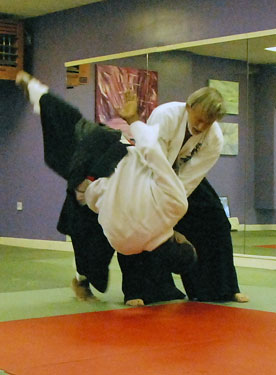
Aikido Takemusukai
Peter Downs,
Itteringham resident and 4th Dan black-belt teaches Aikido at the
Kokoronokai Eastern Arts Centre in Norwich www.attk.tk

Aikido is a martial art founded in the 20th century by Morihei Uyeshiba (died 1969). Uyeshiba was skilled in a variety of traditional Japanese fighting arts, which by their warrior nature were oriented towards killing or at least seriously disabling an opponent. He was also a deeply spiritual person and this led him to develop a martial art that was focused on controlling an attacker, neutralising their aggression without seriously injuring them.
An exponent of aikido does not use physical strength. Indeed a large part of the challenge of doing aikido is learning to control one's own natural “fight or flight” response to an attack. Our bodies are programmed to respond to threat in a very physical way (fight or flight). Even in the non-threatening environment of a training hall beginners in aikido inevitably think that to take an opponent down they must use muscles. Although this may work if you are stronger than your opponent inevitably you will come across opponents who are stronger than you and you will lose.
Uyeshiba used to say that he could never be beaten because he never “fought” his opponents. By this he meant that he never used his physical strength to overcome an opponent. Even as an old man in his 80s, barely five foot tall, he had no trouble in controlling anyone who tried to attack him. Some of the methods he used to achieve this included:
- blending with the movement of his attackers
- adding his own momentum to that of his attacker to take them to an unbalanced position
- applying the principle of levers to enable large effects to result from little effort.
Because aikido does not use physical strength it can be applied equally effectively by both men and women. Indeed women may have an advantage in learning aikido because they are probably less “programmed” than men to respond to threats in a muscular way.
A typical aikido training session will start with a warm up, followed by some gentle stretching. Many people will find that this alone provides physical benefits in terms of improving fitness and flexibility. Once warmed up a variety of techniques may be practised with the teacher usually demonstrating the technique on one of the more advanced students, then students practising in pairs with one providing the attack and the other practising the technique.
Apart from the difficulty of unlearning natural responses to threat, the big challenge for people taking up aikido is learning how to play the part of an attacker effectively. This requires them to attack with commitment and to be able to “accept” the technique applied, which in turn requires them to know how to fall/roll safely forwards or backwards. Many of the techniques in aikido involve a projection (throw) and it is fundamental to safe practice that the person thrown should be able to deal with it effectively. Learning how to break-fall is usually done in slow stages with the pupil first rolling from a sitting position and slowly moving to a more upright standing position.
Although there is a set range of techniques to be learned and these are practised against a variety of attacks, the techniques are really a vehicle for the student to learn how to use their body effectively. Ultimately the goal is to be able to respond intuitively to any attack. This intuitive response may involve an entirely new technique that develops simply from the situation.
The benefits of aikido training include: improved fitness, flexibility, co-ordination, balance and posture; enhanced self-confidence; and improved awareness, concentration and well-being. It's also fun and challenging.